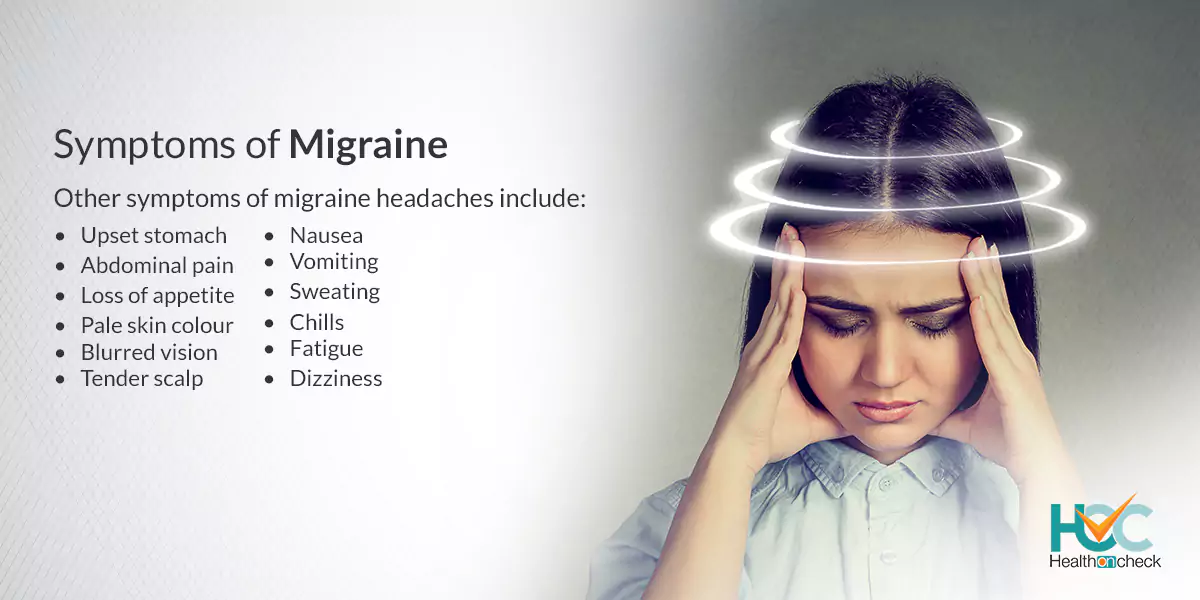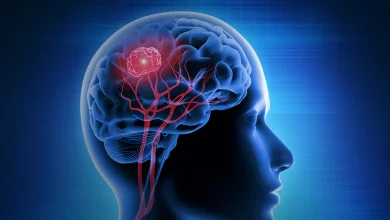What is Migraine?

What is Migraine?
A migraine is a common neurological condition that causes a range of symptoms, most prominently a pounding, pulsing headache on one side of your head. Your migraine usually occurs with physical activity, sounds, smells, or lights. A migraine normally lasts for at least 4-5 hours or even days. According to research, migraine is the sixth most disabling disease in the world. The pain from migraine attacks can be so severe that it starts interfering with your daily activities. The headache because of a migraine comes episodically and sometimes also comes with vomiting, nausea, and light sensitivity.
What are the Types of Migraine?
The types of migraine include:
– Migraine with aura (complicated migraine)
The term aura means the range of symptoms that occur nearly 30 minutes or so before the headache starts. About 15% to 20% of people with migraine experience an aura. The symptoms of aura are normally visual and might include such disturbances as spotting flashing lights or wavy lines, or sometimes you might lose part or all of your vision suddenly for a short period.
– Migraine without aura (common migraine)
It’s the most common type of migraine which occurs without the warning an aura might provide you. The symptoms are the same, but that phase of warning signs doesn’t occur. General symptoms include a throbbing headache of mild-to-severe intensity on one side of the head, intensified by nausea, daily physical activity, and sensitivity to sound (phonophobia) and light (photophobia).
– Migraine without head pain
Also known as “acephalgic migraine” or “silent migraine” it includes symptoms of migraine with aura but without the headache that usually follows.
– Hemiplegic migraine
During this type of migraine, you’ll experience temporary paralysis (hemiplegia) or neurological or sensory changes on one side of your body. The onset of the headache might be connected with short-term numbness, severe weakness on one side of your body, a tingling sensation, a loss of sensation along with dizziness or vision changes. Headache might occur sometimes and sometimes it doesn’t.
– Retinal migraine (ocular migraine)
The symptoms include short-term, partial, or total vision loss in one of your eyes and a dull ache behind the eye that might get spread to the rest of your head. That loss of vision might last a minute, or as long as quite a few months. If you have this type of migraine, then you should always consult with your doctor because it could be a sign of a more serious problem.
– Chronic migraine
During a chronic migraine, the migraine happens at a minimum of 15 days per month. The symptoms might change regularly along with the severity of the pain. People with chronic migraines may be using headache pain medications for above 10 to 15 days per month month and that, unfortunately, can cause headaches that occur even more regularly.
– Migraine with brainstem aura.
In this type of migraine, symptoms such as slurred speech, vertigo, loss of balance, or double vision usually develop before the headache. The pain from a headache might affect the back part of your head. These symptoms generally arrive all of a sudden and can be linked to not being able to speak correctly, vomiting, and ringing in the ears.
– Status migrainosus
It is a rare and serious type of migraine lasting more than 72 hours. The pain from headaches and nausea can be extremely severe. Some specific medications, or medication withdrawal, can result in this type of migraine.
What are the Symptoms of Migraine?
The main symptom of migraine is a headache which can sometimes be described as throbbing or pounding. It might start as a mild ache and then develop into pulsing pain that can be mild, moderate, or severe. If not treated, the pain from the headache will become moderate to severe and can shift from one side of your head to the other, or it might start affecting the front side of your head, the back of your head or you might feel like the pain is affecting your whole head. Pain around their eye or temple, and sometimes in their face, sinuses, jaw, or neck can also be felt by some people.
Other symptoms of migraine headaches include:
– Sensitivity to noise, light, and smells.
– Nausea
– Vomiting
– Upset stomach
– Abdominal pain
– Loss of appetite
– Sweating
– Chills
– Pale skin colour
– Fatigue
– Dizziness
– Blurred vision
– Tender scalp
– Diarrheoa and fever in rare cases
Each phase of the migraine attack can come with different symptoms:
Prodrome symptoms:
– Concentrating problems
– Irritability
– Depression
– Problems in reading and speaking
– Yawning
– Sleeping issues
– Nausea
– Extreme tiredness
– Sensitivity to sound and light
– Food cravings
– More frequent urination
– Stiffened muscle
Aura symptoms:
– Numbness
– Tingling
– Visual disturbances
– Temporary losing sight
– Weakness on one side of the body
– Changes in speech changes.
Headache symptoms:
– Stiffness and pain in the neck
– Depression, anxiety, and/or giddiness
– Sensitivity to light, sound, and smell
– Nasal congestion
– Insomnia
– Nausea
– Vomiting
Postdrome symptoms:
– Difficulties in concentrating
– Depressed mood
– Extreme tiredness
– Lack of comprehension.
– Euphoric mood
What are the Causes of Migraine?
The cause of migraine headaches is complicated and researchers are not yet able to fully understand it. When specific nerves in your blood vessels send pain signals to your brain, a headache occurs. It produces inflammatory substances in the nerves and blood vessels of your head. It’s not clear why your nerves do it.
Some trigger points of headaches might include hormonal changes in women, fluctuations in oestrogen, like before or during menstrual periods, pregnancy, and menopause.
Hormonal medications, including oral contraceptives, can also make migraines worse.
Some causes of migraines might include:
– Drinks
Drinking some fluids like alcohol, especially wine, and too much caffeine, like coffee, can cause a migraine.
– Stress
Stress at home or work or home can lead to migraines.
– Sensory stimuli
Bright or flashing lights or loud sounds can prompt migraines. Also, some strong smells including paint thinner, perfume, secondhand smoke, etc. can trigger migraines in some people.
– Sleep changes
Less sleep, missing sleep, or sleeping too much can also cause migraines in a few people.
– Physical strain
Extreme physical exertion, like sexual activity, may prompt migraines.
– Weather changes
A change of weather or barometric pressure can initiate a migraine.
– Medications. Oral contraceptives and vasodilators, like nitroglycerin, can prompt migraines.
– Foods
Some foods such as aged cheeses and salty and processed foods may trigger migraines. Skipping meals can also cause a migraine. The sweetener aspartame and the preservative monosodium glutamate (MSG), found in many foods can also trigger migraines.
What are the Risk Factors of Migraine?
The risk factors of migraine might include:
– Family history
If any of your family members has migraines, then your chances of developing them also increase.
– Age. Migraines can start at any age, but they usually first often happen during adolescence. Migraines usually peak in the 30s, and slowly become less severe and less frequent in the coming years.
– Sex
Women are more prone to having migraines than men.
– Hormonal changes
Hormonal changes because of menstruation also increase the risk of migraines. Normally migraines improve after menopause.
What are the Complications of Migraine?
Most migraines don’t cause serious complications but rarely, you might suffer a complication known as migrainous infarction. It occurs when you get a stroke whilst having a migraine. But there’s no evidence of a migraine causing a stroke.
Though it’s quite rare, a hemiplegic migraine might sometimes result in a coma or other serious complications.
A very severe headache that begins all of a sudden might be a sign of another, more serious complication, such as a stroke or aneurysm. You should seek medical assistance right away if it occurs.
Taking painkillers to treat pain because of headaches too often might lead to serious medication-overuse headaches. The risk is highest with medicines such as acetaminophen, aspirin, and caffeine combinations. You will develop overuse headaches if you take aspirin or ibuprofen for above two weeks days a month or triptans, rizatriptan, or sumatriptan for above ten days a month.
How Migraine is Diagnosed?
If you suffer from migraines or have a family history of migraines, then a specialist trained in treating headaches, called a neurologist, will diagnose migraines depending on your symptoms, and medical history, along with a physical and neurological examination.
If your condition is abnormal, complex or all of a sudden becomes severe, tests are done to rule out other causes for your pain. These tests might include:
– MRI scan
In this test, a powerful magnetic field and radio waves are used to produce detailed images of your blood vessels and brain.MRI scans help diagnose tumours, infections, bleeding in the brain, strokes, and other brain and nervous system problems called neurological conditions.
– CT scan
A series of X-rays are used during a computerised tomography (CT) scan to produce detailed cross-sectional images of the brain. This test helps diagnose tumours, brain damage, infections, bleeding in the brain, and other possible medical issues that might be causing headaches.
What are the Treatment Options Available for Migraine?
Migraine headaches are chronic which means they can’t be cured, but treatments can help to manage and possibly improve the condition. Two main treatment approaches use medications which are called abortive and preventive.
– Abortive medications
They are quite effective when you use them when you notice the first sign of a migraine. These medicines are taken when the pain is mild. Abortive medications help stop or reduce the symptoms of migraines such as pain, light sensitivity, nausea, etc. by possibly stopping the headache process. Some abortive medications help to tighten your blood vessels and bring them back to normal along with relieving the pulsating pain.
– Preventive (prophylactic) medications
These medicines are usually given when your headaches are severe, happen over four times a month, and are notably hindering your daily activities. Preventive medications decrease the severity and frequency of the headaches. Medications are usually taken daily to prevent migraines.
For some people with mild to moderate migraines over-the-counter medications are effective. The main components in pain-relieving medications are aspirin, ibuprofen, naproxen, acetaminophen, and caffeine.
Three over-the-counter products approved to treat migraine headaches include:
Motrin Migraine Pain.
Excedrin Migraine.
Advil Migraine.
Prescription drugs for migraine headaches include:
Triptan class of drugs (abortive medications):
Zolmitriptan.
Sumatriptan.
Naratriptan.
Calcium channel blockers:
Verapamil.
Calcitonin gene-related (CGRP) monoclonal antibodies:
Erenumab.
Fremanezumab.
Eptinezumab.
Beta-blockers:
Propranolol.
Atenolol.
Nadolol.
Antidepressants:
Nortriptyline.
Amitriptyline.
Doxepin.
Venlafaxine.
Duloxetine.
Antiseizure drugs:
Valproic acid.
Topiramate.
Other:
Steroids.
Corticosteroids.
Phenothiazines.
You might be prescribed minerals, vitamins, or herbs, including:
Riboflavin (vitamin B2).
Co-enzyme Q10.
Magnesium.
Feverfew.
Butterbur.
Medicines to relieve migraine pain come in an array of forms such as tablets, pills, injections, nasal sprays, and suppositories. You should discuss with your doctor about certain medications, combinations of medications, and formulations to best give you relief from headache pain.
If required medicines to relieve nausea are also given.
Alternative migraine management methods, also called home remedies, usually include:
– Taking rest in a quiet, dark, cool room.
– Applying a cold compress or washcloth on your forehead or the backside of your neck.
– Massaging your scalp.
– Yoga.
– Applying pressure to your temples in a circular motion.
– Be calm.
– Meditating.
– Biofeedback.
Living with Migraine
Migraine headaches can create quite a few serious problems and make it difficult for you to go to work, school or do other daily chores. Thankfully, there are various ways to prevent migraine and manage and control the symptoms. You should discuss this with your doctor and create a treatment plan to keep migraines at bay from creating problems in your life.
Whom to Consult?
If your headache doesn’t go away or keeps coming back, then you should consult with your doctor. If you have a headache with other complications including a stiff neck, nausea, vomiting, fever, weakness, fatigue, numbness, or weakness in the limbs, along with problems while speaking, you shall visit your doctor and get yourself diagnosed. Your doctor will diagnose your problem and start treatment accordingly.






